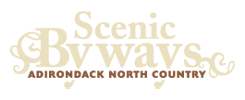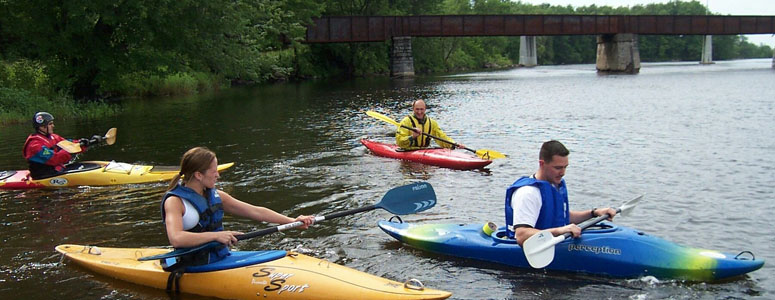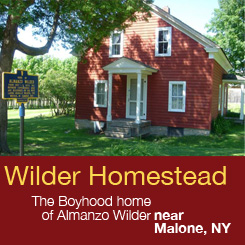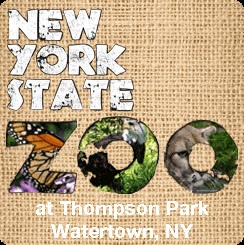
“Spectacular scenery unlike any
other in the Northeast.”
| Lake George Arts Project and Court House Gallery |
| Fonda Old Court House and Historical Archives |
| Northampton Boat Launch |
| Nicks Lake NYSDEC Campground |
| Northville Bridge |

Explore by interest:
 VIEW AREA MAPS Maps of the region to view or print.
Area Maps
VIEW AREA MAPS Maps of the region to view or print.
Area Maps
 LOOKING for more information on Where to Stay and Where to Dine?
Plan Your Stay
LOOKING for more information on Where to Stay and Where to Dine?
Plan Your Stay
 CARING for our favorite natural and recreational resources - See the new guide
Invasive Species Alert
CARING for our favorite natural and recreational resources - See the new guide
Invasive Species Alert
Learning a new skill is a great way to spend the day on a trip along the Adirondack North Country Scenic Byways (by Teri Ellis)
About The Adirondack North Country Region
 The Adirondack North Country region comprises 14 counties west of Lake Champlain and east of Lake Ontario that stretch north from the Mohawk River to the Saint Lawrence River and the Canadian border. The region's history is as rich and diverse as its landscape is unique and varied. The lakes, ponds, rivers and mountains of the six-million acre Adirondack Park in the center of the region offer myriad recreation and wilderness opportunities.
The Adirondack North Country region comprises 14 counties west of Lake Champlain and east of Lake Ontario that stretch north from the Mohawk River to the Saint Lawrence River and the Canadian border. The region's history is as rich and diverse as its landscape is unique and varied. The lakes, ponds, rivers and mountains of the six-million acre Adirondack Park in the center of the region offer myriad recreation and wilderness opportunities.
Information on a number of topics is provided below.
Adirondack Park
New York State’s Adirondack Park, 9,375 square miles within a boundary created by the state legislature in 1892, is a unique blend of public and private lands comprising the largest state park in the lower 48 states. The six-million-acre park has just over three million acres in private ownership and one million acres of the Park’s public land are designated as wilderness. The Adirondack Park is home to 135,000 residents in 105 towns and villages and the summer population soars with seasonal residents and visitors. There is a long tradition of craftsmanship, resourcefulness, and hospitality as well as rugged beauty and rustic charm. The Adirondack Museum in Blue Mountain Lake is a world-class museum with numerous displays of the region’s history and culture.
The Adirondack Research Consortium was formed in 1994 when a small group of academic researchers and leaders of Adirondack-focused nonprofit organizations recognized the need for research-based knowledge to inform and guide policies, planning, and management of the Adirondack Park’s public and private lands.
Adirondack Park Agency
The Adirondack Park Agency (APA) was created in 1971 by the New York State Legislature to develop long-range land use plans for both public and private lands within the boundary of the Park. TheAPA is a New York State governmental agency with an eleven-member board and a staff of 60+ people. The Agency Board meets monthly to act on Park policy issues and permit applications.
New York State lands within the Adirondack Park have been given one of the following designations by the APA: wilderness, primitive, canoe, wild forest, intensive use, historic, and state administrative.
Private lands within the Adirondack Park have the following classifications: hamlet, moderate intensity use, low intensity use, rural use, resource management, and industrial. The land classifications in the Adirondack Park Agency Act are designated to channel development into areas where it is best supported and to control the overall density of development. While very few activities are prohibited by the Act, some activities are prohibited in certain land use areas.
See: The Adirondack Park for more information on the Adirondack Park.
NYS DEC
The New York State Department of Environmental Conservation New York State Department of Environmental Conservation was created on July 1, 2023 to bring together in a single agency all state programs directed toward protecting and enhancing the environment. NYS DEC's goal is to achieve this mission by embracing the elements of sustainability - the simultaneous pursuit of environmental quality, public health, economic prosperity, and social well-being, including environmental justice and the empowerment of individuals to participate in environmental decisions that affect their lives.
Campgrounds and State Parks
In New York State’s Adirondack and Catskill parks, the NYS Department of Environmental Conservation NYS DEC operates 52 campgrounds that provide a wide variety of experiences, including island camping, tent and trailer camping, boat launching facilities, hiking trails, beaches, and day use areas with picnic tables and grills.
Sporting (Fishing, Hunting, and Trapping) Licenses
Information about purchasing a New York State sporting license and related links are available from NYS DEC.
Boat Permits
Information about boat registration in New York State is available from the NY DMV. For general information about boating on New York State waterways, including measures to prevent the spread of invasive species, visit the NYS DEC website.
The Lake George Park Commission provides information about one-day, one-week or annual boat registrations for Lake George.
Wildlife and Ecology
The Adirondack Ecological Center is the leader in ecological sciences in the Adirondack Mountains of northern New York and a major contributor to the science internationally. Established in 1971 by the State University of New York College of Environmental Forestry (ESF) in Syracuse, the AEC provides the science that underpins the management of the Adirondack Park as one of the world's foremost experiments in conservation and sustainability.
The Adirondack region is part of the UNESCO-designated Champlain-Adirondack Biosphere Reserve.
Stewardship: Environmental Groups & Organizations
The Adirondack Council is a not-for-profit environmental group that has been working since 1975 to protect the open-space resources of New York State's six-million-acre Adirondack Park and to help sustain the natural and human communities of the region.
The PROTECT the Adirondacks! is a non-profit, grassroots membership organization dedicated to the protection and stewardship of the public and private lands of the Adirondack Park. PROTECT! is a consolidation of two organizations that occurred in 2009, the Residents Committee to Protect the Adirondacks and the Association for the Protection of the Adirondacks. The mission of the new organization is to be dedicated to the protection and stewardship of the public and private lands of the Adirondack Park, and to build the health and diversity of its human communities and economies for the benefit of current and future generations. Protect the Adirondacks looks to a future in which the wild character, ecological integrity and mutual well being of the natural and human communities of the Park are sustained.
The Natural History Museum of the Adirondacks, also known as the The Wild Center, is located on a 31-acre site in the Town of Tupper Lake. The Wild Center’s mission is to inspire a broad public understanding of the natural systems that shape and sustain life in the Adirondacks.
Invasive Species
The Adirondack Park Invasive Plant Program is a regional cooperative effort initiated in 1998 among citizens and organizations of the Adirondacks that administers two projects: the Aquatic Invasive Plant Project and the Terrestrial Invasive Plant Project. Its mission is to protect the park from the negative impacts of nonnative invasive plants.
Public Transportation
Amtrak’s “Adirondack” route from New York City to Albany to Montreal provides daily rail service to communities in the eastern Adirondack’s Hudson-Champlain valley.
Trailways provides scheduled bus service to various locations in New York State and Canada.
Commercial airline service is available to the south in Albany and Syracuse, to the west in Watertown, to the north in Massena and Ogdensburg, to the east in Plattsburgh and Burlington, Vt., and to the Lake Clear Airport near Saranac Lake.
Directions
The Adirondack North Country region can be accessed from the south via the New York Thruway (I-90), the Adirondack Northway (I-87), and I-81. From Massachusetts, use I-90 to reach the New York Thruway (I-90) or the Adirondack Northway (I-87). From Vermont, several ferries cross Lake Champlain, the Crown Point Bridge connects Vermont Highway 17 with NY’s Essex County Route 8, and US Route 4 connects with NY Route 22. From the west, take the New York Thruway (I-90) to I-81. From the north, a number of bridges cross the St. Lawrence River and provide access to NY State Routes 3, 30 and 812.
Road Conditions
There are two main sources of road condition information from the NY State Department of Transportation, at NYS DOT or 511NY.
For road conditions for the NY State Thruway only, try NYS Thruway.
International Travel, Border Crossing
Information on border crossing is available from the (U.S.-Canadian border). General information on border crossings and customs is also available on the I Love NY website.
Beginning January 31, 2008, U.S. and Canadian citizens 19 years and older who enter the U.S. at land and sea ports of entry from within the Western Hemisphere will need to present government-issued photo ID, such as a driver's license as proof of identity, along with proof of citizenship, such as a birth certificate or naturalization certificate, or a passport. Children age 18 and under will be able to enter with proof of citizenship. Verbal claims of citizenship and identity alone will not be sufficient to establish identity and citizenship for entry into the United States.
Note: Children age 18 and under will need to present a birth certificate, naturalization certificate, a passport, or other approved form of identification to enter the U.S.A. see: U.S. Get You Home or the State Department website.
Rest Areas
The portion of Interstate 87 (the Northway), which traverses the eastern Adirondack Park and NYS North Country region, has a northbound rest area near Clifton Park (between Exits 9 and 10, northbound only), and north- and southbound rest areas near Glens Falls (between Exits 17 and 18), near Schroon Lake (between Exits 27 and 28), near North Hudson (between Exits 29 and 30), near Elizabethtown (between Exits 30 and 31), and between Plattsburgh and the Quebec border at Beekmantown. The High Peaks Welcome Centers, the North Hudson rest areas, provide extensive travel and tourism information about the Adirondack North Country region.
Rest areas are found on I81 between Syracuse and Watertown.
Visitor Centers
There are two Visitor Interpretive Centers (VICs), one in Newcomb and and one in Paul Smiths. They were created by the State of New York to introduce residents and visitors to the wonders of the Adirondack Park, the East's greatest wilderness. They serve as environmental education and visitor orientation centers, complete with trail systems, visitor information services, special events, historical and environmental exhibits, and a year-round schedule of public programs. In 2011, both VICs began being operated by colleges: Newcomb VIS by SUNY-ESF and the Paul Smiths VIC by Paul Smiths College.
While their websites are under development, some information can be found here: Newcomb VIC Paul Smiths VIC.
The Adirondack Community Information Center project is a region-wide effort focused on increasing the flow of Adirondack information among organizations, residents, and visitors and is spearheaded by the Wildlife Conservation Society.
Climate and Weather
The region has a northern climate that is generally made cooler and more unpredictable by the higher elevations in some areas. Winter travel can be hazardous when snow or ice covered roads predominate. Cell phone coverage is not available in all areas, so standard winter safety gear is recommended. Day-time summer temperatures are often pleasant but nights can be cool. When in the mountains or in a forest, storms can move in quickly without much warning, so extra clothing is a good idea if the weather is questionable.
First Aid, Hospitals
There is an emergency squad in most communities and many have a small clinic. Hospitals are uncommon within the Adirondack Park, available only in Elizabethtown, Saranac Lake, Star Lake, and Ticonderoga.
Cell Phones
New York State law prohibits use of a hand-held mobile telephone while driving (see: cell phone fine).
Cell phone coverage can be limited or non-existent in the portions of the Adirondack Park and in other rural areas of region. Not all communities have cell service and some will have service in one area, but not in another.
Bicycle Touring
Many of the Adirondack North Country Scenic Byways have wide shoulders, allowing for pleasant bicycle touring through the region. The website Bike Adirondacks provides information on bicycling in the region and includes contact information for many of the bike shops in the area. New York State DMV offers information on helmet laws for bicyclists and in-line skaters.
Canoe and Kayak Touring
From its western terminus at Old Forge, New York the 740-mile Northern Forest Canoe Trail begins its journey along the Fulton Chain of Lakes, following the historic path of loggers, trappers, Adirondack guides, early steamboats and Native Americans. The Trail extends for 148 miles through the varying waterways (from flat water to white water) of the Adirondack Park before reaching Lake Champlain via the Saranac River. The remainder of the Trail extends across Vermont, New Hampshire, Quebec, and Maine, finding its eastern terminus in Fort Kent, Maine. Visit the Northern Forest Canoe Trail for more information.
Snowmobiles
A New York State registration is required for all snowmobiles operated in New York State, unless the snowmobile is operated on the private property of the owner or private property the owner has a contractual right to use. New York State DMV also requires a registration on trailers.
Canoe and Kayak Touring
From its western terminus at Old Forge, New York the 740-mile Northern Forest Canoe Trail begins its journey along the Fulton Chain of Lakes, following the historic path of loggers, trappers, Adirondack guides, early steamboats and Native Americans. The Trail extends for 148 miles through the varying waterways (from flat water to white water) of the Adirondack Park before reaching Lake Champlain via the Saranac River. The remainder of the Trail extends across Vermont, New Hampshire, Quebec, and Maine, finding its eastern terminus in Fort Kent, Maine. Visit the Northern Forest Canoe Trail for more information.
ATVs
A New York State DMV registration is required for any ATV driven on public property or private property in the state, unless only used for agricultural purposes or not-for-hire snow removal on private property. A registration for an ATV that was issued in another state to a resident of that state is valid in NYS.
Traveling with Pets
Keeping pets on a leash is strongly advised, both for the protection of the pet for the protection of wildlife in the area.


